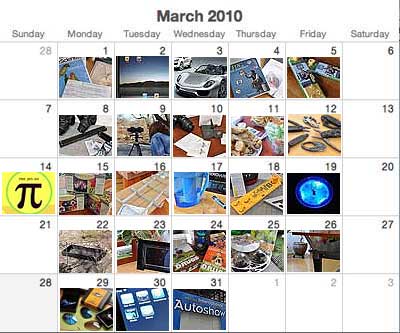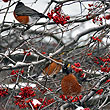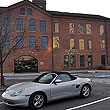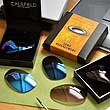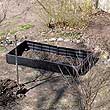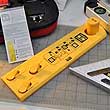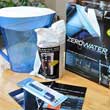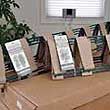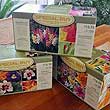The release of the iPad on Saturday sucked everyone into a digital black hole. After a few marathon review sessions of all things iPad, we defied known physical laws, climbed our way back up to the event horizon, and managed to extricate ourselves from the gravitational field-distorting pull of our shiny new iPad. The unseasonably warm 90º weather helped. To make sure that the "real" world was indeed still analog and to help us regain our bearings, we
decided to do some gardening.
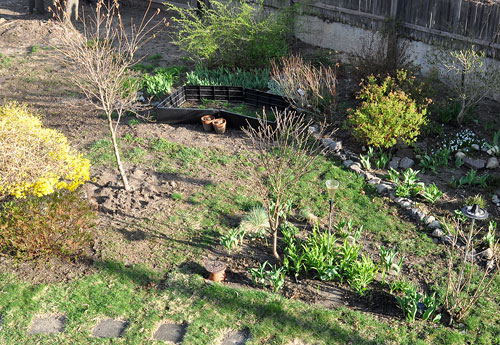
When we last left the RainyDayGarden, we had assembled the GrowBed from our friends at the Gardener's Supply Company. We were trying out various shapes for the bed and decided a chevron configuration was the best fit for our existing garden layout.
The next step was to fill the GrowBed with garden soil. The size of the GrowBed is 3'x6'x10", so 18 cubic feet (CF) should be sufficient. To help us keep our cost down, we decided to get 12 CF of top soil ($1.50/CF) and 6 CF of gardening soil from MiracleGro ($4/CF).

The MiracleGro's claim is that stuff grows twice as big if planted in it. We didn't set up a double-blind test bed (next season) so we won't be able to say. However, it is more than twice as expensive as regular top soil, so let's hope they are at least a little better:-) Also, instead of mixing the different soil together, it would be best to put the MiracleGrow on top. This way, the seedlings will benefit from the "better" soil.

With the help of a few extra hands, we made short work of
filling the GrowBed. We unpacked the vegetable ladders and bean cages and determined how best to arrange the garden.
We will be using the GrowBed planner from Gardener's Supply Company.
For now, we just wanted to get a feel for the sturdiness of the ladders. We will likely reposition them when we are ready to plant.
It is important to have the ladders in place before the plants get established (i.e., are bigger than your hand). Putting the cages in early prevents damage to the root systems, because it allows the roots to grow around them and not be damaged by jamming the suports through an established root system.


We have already said that these ladders and cages are more substantial
than the ones from our local gardening center.
That was immediately apparent when we put them side by side with the ones we used last season.
The new ladders differ from the old ones in a couple of ways as well. Their rounded-V shape is designed to protect plants from wind and accidental breakage. The cradle-shaped cross-members makes it easier to set the ladders into the ground and provides multiple places for vines to rest. The taller Tomato Ladders will let us make the most of our 3'x6' garden space.
The only flaw we found in one of our six ladders was that a weld was broken. It should not affect the overall integrity of the frame, but we may see if can solder it back together anyway.
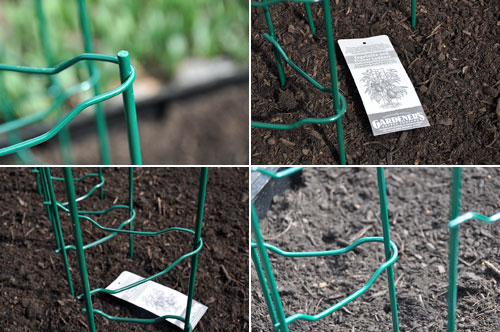
Next up was the Bean Tower.
The tower comes in two pieces, is made of galvanized steel wire, and requires only 1.5 square feet of space. The lower piece has longer legs (10") for in-ground stability. It also has tubes at the top to mate with the upper portion to form one tall structure.
When assembled, the tower is over 65".
For folks living in extra windy locations, there are anchors available to further secure the structure.
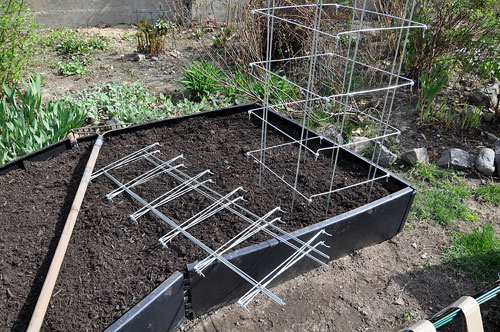
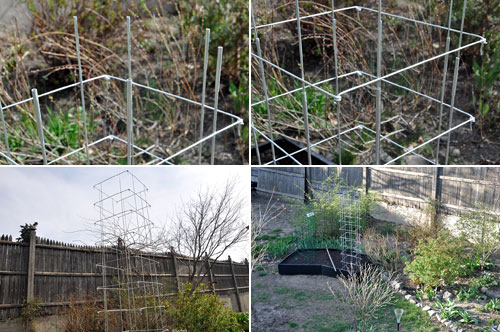
The seeds we planted have sprouted and are growing happily in their egg-carton incubators. We have been moving them outside during the day to harden them for planting. The bean seedlings should be ready in a week or so and the herb seedlings should be ready by late April. We expect to purchase the rest from our local sources.

Getting the above-ground garden set up was very simple. The amount of space required was very small, certainly a size available to most folks in the suburbs and to many city-dwellers. We are excited by the possibility of being able to grow a lot of vegetables by using the vertical ladders and frames and are looking forward to a very productive RainyDayGarden. [Permalink] -Garden prep
|

